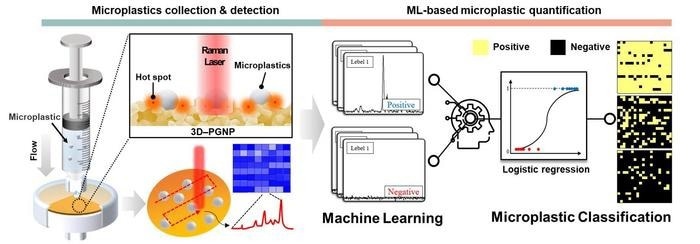
Syringe filter-type MPs detection kit and artificial intelligence-based analysis technology. Image Credit: Korea Institute of Materials Science (KIMS)
The study team created a device for on-site applicable MP detection. This kit utilizes a syringe filter-type MP detection system, allowing for the identification of the type, number, and distribution of MPs within just 20 minutes without any need for pre-treatment.
The team's innovation lies in the filtration capability of MPs. They designed a plasmonic material shaped like a nanopocket, capable of capturing MPs on the surface of a paper filter with microscale pores. This material enhances the optical signal of the captured MPs.
When a sample solution containing MPs is injected through a syringe, the Raman spectral signal of the MPs is intensified on the nanopocket-type plasmonic material, enabling highly sensitive detection. Remarkably, this technology can also detect MPs at the nanometer scale.
In addition, the research team pre-trained an artificial intelligence (AI) system on the unique Raman spectroscopy signals of MPs so that the AI can determine whether the detected signal corresponds to MPs, even if there are interfering elements in the sample.
This technology allows for MPs to accurately be identified, even in complex environments or human samples, as well as their concentration, distribution, and type.
Existing technologies for detecting MPs have been difficult to use in the field. This is because it requires complex pre-treatment, high-performance equipment, and analysis by skilled researchers. This technology replaces the pre-treatment process in the form of a filter and improves the sensitivity of the material rather than increasing the performance of the equipment.
Additionally, the main differentiator is that the analytical skills of skilled researchers have been replaced by machine learning.
The detection device also has the advantage of using a portable Raman spectrometer, which increases the possibility of on-site detection.
At present, there are some concerns surrounding the human risk and environmental pollution related to MPs.
However, to date, there is no method to detect small MPs of micro or nano size, so there is a need to develop technology to establish an international standard detection method. This could potentially lead to future regulations on plastic products and food and beverage containers.
Another advantage of this technology is that the general public can easily use it when necessary since the sensor is made as a kit.
If this technology is commercialized, the technology for detecting MPs universally will be more easily and rapidly disseminated. Based on this, KIMS will continue to spare no effort in developing material technologies for the safety of the people and future generations.
Dr Ho Sang Jung, Senior Researcher, Korea Institute of Materials Science
The KIMS Basic Project, The Ministry of Science and ICT provided funding for this study. The study’s findings were released on September 10th, 2023, in the prestigious academic journal Advanced Functional Materials (IF: 19, JCR <5%), which specializes in the study of materials.
To help standardize MP-detecting technologies in the future, the study team intends to work with the KOTITI Testing & Research Institute and is currently working on follow-up studies to identify MPs according to size and assess their toxicity to humans.
Journal Reference:
Kim, J. Y., et al. (2023) 3D Plasmonic Gold Nanopocket Structure for SERS Machine Learning-Based Microplastic Detection. Advanced Functional Materials. doi:10.1002/adfm.202307584.